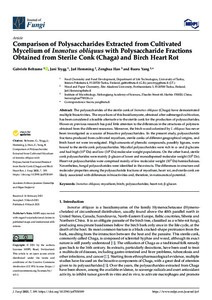Comparison of Polysaccharides Extracted from Cultivated Mycelium of Inonotus obliquus with Polysaccharide Fractions Obtained from Sterile Conk (Chaga) and Birch Heart Rot
Beltrame Gabriele; Trygg Jani; Hemming Jarl; Han Zenghua; Yang Baoru
Comparison of Polysaccharides Extracted from Cultivated Mycelium of Inonotus obliquus with Polysaccharide Fractions Obtained from Sterile Conk (Chaga) and Birch Heart Rot
Beltrame Gabriele
Trygg Jani
Hemming Jarl
Han Zenghua
Yang Baoru
MDPI
Julkaisun pysyvä osoite on:
https://urn.fi/URN:NBN:fi-fe2021050328512
https://urn.fi/URN:NBN:fi-fe2021050328512
Tiivistelmä
The polysaccharides of the sterile conk of Inonotus obliquus (Chaga) have demonstrated multiple bioactivities. The mycelium of this basidiomycete, obtained after submerged cultivation, has been considered a feasible alternative to the sterile conk for the production of polysaccharides. However, previous research has paid little attention to the differences in the structures of polymers obtained from the different resources. Moreover, the birch wood colonized by I. obliquus has never been investigated as a source of bioactive polysaccharides. In the present study, polysaccharide fractions produced from cultivated mycelium, sterile conks of different geographical origins, and birch heart rot were investigated. High amounts of phenolic compounds, possibly lignans, were bound to the sterile conk polysaccharides. Mycelial polysaccharides were rich in alpha- and beta-glucans and had high (10(5) Da) and low (10(4) Da) molecular weight populations. On the other hand, sterile conk polysaccharides were mainly beta-glucan of lower and monodispersed molecular weight (10(3) Da). Heart rot polysaccharides were comprised mainly of low molecular weight (10(3) Da) hemicelluloses. Nevertheless, fungal polysaccharides were identified in the extracts. The differences in structure and molecular properties among the polysaccharide fractions of mycelium, heart rot, and sterile conk are likely associated with differences in bioactivities and, therefore, in nutraceutical potential.
Kokoelmat
- Rinnakkaistallenteet [27094]
